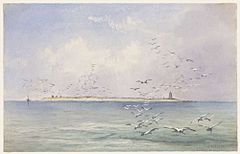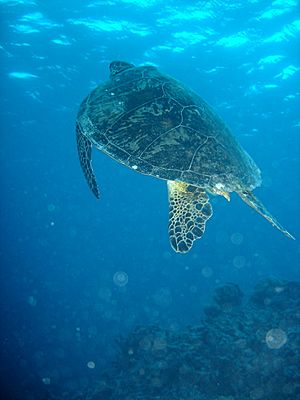Raine Island facts for kids

Raines Islet on the Great Barrier Reef by Edwin Augustus Porcher, painted 1844
|
|
| Geography | |
|---|---|
| Coordinates | 11°35′30.24″S 144°2′17.14″E / 11.5917333°S 144.0380944°E |
| Area | 32 ha (79 acres) |
| Administration | |
|
Australia
|
|
| State | Queensland |
| Protected Area | Great Barrier Reef Marine Park |
Raine Island is a small, green coral island covering about 32 hectares. It's located on the outer edge of Australia's amazing Great Barrier Reef. This special island is about 620 kilometers (385 miles) north-northwest of Cairns in Queensland. It's also about 120 kilometers (75 miles) east-northeast of Cape Grenville on the Cape York Peninsula.
Raine Island is super important because it's home to the world's biggest group of green turtles. It also has the oldest European building in tropical Australia, a stone beacon built way back in 1844. Because it's so important for nature, the island is completely protected. No one can visit without special permission. The island was named after Captain Thomas Raine, an English sailor who found it.
Contents
Geography
Raine Island is a coral island with low-growing plants. It has a center made of phosphate rock, which is a type of rock rich in minerals. This center is surrounded by sand and large coral reefs. The island sits right next to a shipping route called the Raine Island Entrance. This entrance helps ships get into the waters of the Great Barrier Reef.
Environment
Turtles and Nesting
Raine Island is the most important place in the world for green sea turtles to lay their eggs. Imagine up to 64,000 female turtles coming to this small sandy island in just one season! The number of turtles can change a lot, from less than 1,000 to over 10,000. This often depends on weather patterns like El Niño.
The waters around Raine Island are so full of turtles that you might see more than 250 in just one hour! Turtles have been nesting here for over 1,000 years. This makes it the oldest known place where marine turtles gather to lay eggs anywhere in the world.
Sometimes, as many as 100,000 female turtles have been seen nesting in one season. This means Raine Island produces 90% of the green turtles in this whole region! However, in the 1990s, fewer eggs were hatching. Also, thousands of female turtles were getting stuck or dying trying to climb the small sandy cliffs to nest. The shape of the island had changed, and nests were at risk of being flooded by the ocean.
So, from 2011 to 2020, a big team worked together to help. This team included the Queensland Government, a company called BHP, the Great Barrier Reef Marine Park Authority, the Great Barrier Reef Foundation, and the Wuthathi and Meriam traditional owners. They used heavy machines to reshape the island. This made it easier for female turtles to reach their nesting spots and reduced the risk of nests being flooded. They also used cool technology like 3D modelling, satellites, and drones to watch and study the turtles. This monitoring continues today.
As of June 2020, scientists are working on "The Turtle Cooling Project." They are from the World Wildlife Fund Australia, University of Queensland, Deakin University, and the Queensland Government. They are studying how global warming affects green turtle breeding in the north. Warmer temperatures can cause more female turtles to hatch, which can upset the balance. They are doing this important work around Raine Island, Heron Island, and Moulter Cay.
Birds
More than 30 different kinds of birds have been seen on Raine Island. The island is a very special place for seabirds to breed and rest. It's considered the most important tropical seabird breeding spot in the entire Great Barrier Reef.
Raine Island National Park (Scientific) includes Raine Island itself, plus two nearby small islands called Moulter and MacLennan Cays. This area is recognized by BirdLife International as an Important Bird Area. This is because it supports over 1% of the world's population of nesting masked boobies and brown boobies. It also has many common and black noddies. Plus, it's home to important numbers of herald petrels, red-footed boobies, and red-tailed tropicbirds.
History
Raine Island is part of the traditional lands and waters of the Wuthathi Aboriginal people. They share their interests in this area with Torres Strait Islander peoples, including the Erubam Le (from Darnley Island), the Ugarem Le (from Stephen Island), and the Meriam Le (from Murray Island).
In the 1890s, people mined the island for guano, which is bird droppings used as fertilizer.
The Beacon
The waters around Raine Island were very dangerous for early European ships. More than thirty shipwrecks can be found near the island. One famous shipwreck is the HMS Pandora, a ship that captured some mutineers from the HMS Bounty in 1791.
Because of these dangers, a stone beacon was built in 1844. The British Navy ordered it to be built by convicts. This beacon is the oldest European building in tropical Australia. The stones used to build it came from the island's own phosphate rock. The wood was taken from shipwrecks, and shells were burned to make the mortar. It took four months to build. Even though it was never a lighthouse, you can see the beacon from over 24 kilometers (15 miles) away!
Over the years, the beacon started to fall apart. Erosion, bad weather, and lightning strikes damaged it. In 1988, a group called the Raine Island Corporation fixed it up to make it safe. They even won an award for their great work in protecting history. The beacon is now considered one of the most important historical sites in the Great Barrier Reef Marine Park. It is listed on the Queensland Heritage Register and the Commonwealth Register of the National Estate.
National Park (Scientific)
In August 2007, Raine Island and its nearby small islands, Moulter and MacLennan Cays, became a National Park (Scientific). This happened under Queensland's Nature Conservation Act 1992.
This means Raine Island has the highest possible level of legal protection. Only scientists and people doing essential management work are allowed to visit. This helps protect the seabirds and turtles that breed there.
This special protection was possible because the Wuthathi people and interested Torres Strait Islanders agreed to it. They signed a special Indigenous Land Use Agreement with the State.
Heritage listings
Raine Island has some important historical sites, including:
- Eastern end of Raine Island: Raine Island Beacon
See also
 In Spanish: Isla Raine para niños
In Spanish: Isla Raine para niños


